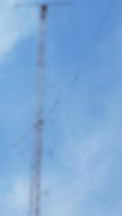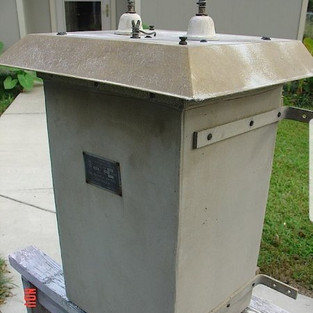
Above, Distributed Fed Curtain type, stacked "X" Rhombic Steerable Array, looking 195Ft down to 90Ft
The top "X" Rhombic antenna is at 190Ft just under the HF Log-beam, the lower element is at 90 foot
The Big Project in 2019 was a Distributed fed Curtain stacked Rhombic Steerable array (DRS) or USIA this array is for 40 meters and up. This project is now "In the Air and On the Air". The antenna uses a distributed curtain type fed arrangement. It utilizes a reflector instead of terminating resistors for direction providing maximum front to back, and not wasting power in the terminating resistors. Up to 3db is added to the antenna forward gain and another 3db by utilizing reflectors, while also increasing the front the back ratio even higher (it is like a brick wall). This antenna is steerable plus or minus 30° using electronic phasing. The upper rhombic is at about 190 feet, the lower rhombic is at 100 feet. This antenna is designed with steerable directivity and wave angle phasing. The main area of interest for this antenna will be Northern to Southern Europe, the Mediterranean, Northern Africa and the Mideast.
What is HRS/USIA Array, Distributed Fed Curtain using Stacked X Rhombics Steerable (DRS)?
Most people incorrectly call the HRS, USIA or Distribution fed curtains, "Sterba curtains". But there are some big differences in performance and construction of broadcast type curtain arrays, like the horizontally polarized Distributed Fed Curtain arrays or USIA arrays and the much lower gain vertically polarized Sterba curtain or Bobtail antenna.
Distributed fed curtains use a series of common points, each feed from equal length low loss transmission lines, to distribute power. The conductor loss is less, phase error is significantly reduced, and all elements receive equal currents. This feed method places conductor resistances in parallel, and makes array patterns stable over very wide frequency excursions. In addition to having more gain, a distributed fed curtain (such as USIA arrays used at Shortwave broadcast sites) can be used over a 2:1 or broader frequency range with minimal gain and pattern change. It is very easy to make a distributed feed curtain operate on 80, 40 & 20 meters with full gain and no pattern distortion. A distributed or branched feed curtain also allows designers to use optimum element spacing. This means a 4-element branch fed curtain can provide the highest gain per acre of any antenna design. The stacking height compresses the signal in elevation. This is the vertical count of layers, the number of columns, bays, or array width compresses the signal in azimuth. Despite occupying a tiny fraction of the space required for the VOA rhombics, the USIA style curtains are the highest gain arrays used at VOA's International and others Broadcasts like the new WBCQ Ampegon 22db gain antenna system. However this type of antenna is not commonly known to most amateur operators, where the associated feeder system in a multiband, horizontal-dipole, curtain antenna, as used for high power operation in short-wave broadcasting. These forms include vertically polarized arrays like the Bobtail, Sterba, Bruce arrays, and H arrays. They also more commonly include horizontally polarized arrays like bed-spring arrays, H curtains, lazy-H antenna arrays, or distributed feed curtains like the USIA arrays or HRS arrays used for shortwave Broadcast. The nomenclature conventionally used to describe horizontal-dipole, curtain antennas has been standardized internationally, using the form HR m/n/h, with the following meaning (International Telecommunication Union, 1984):
HR:
horizontal dipole curtain antenna with reflector curtain
m/:
number of dipole elements in each row
n/:
number of dipole elements in each stack (one above the other)
h/:
height above ground, in wavelengths, of the bottom row of radiating elements.
The K0UO Distributed-fed Curtain uses stacked X Rhombics, and it is a steerable design. To see more info on the W7YRV/SK "X" Rhombic design, see Roy's Blog @ w7yrv.blogspot.com/2013/
An HRS type antenna is basically a rectangular array of conventional dipole antennas strung between supporting towers. In the simplest case, each dipole separated from the next by 1⁄2 λ vertically, and the centers of each antenna are spaced 1 λ apart horizontally. Again, in the simplest case (for a broadside beam), all dipoles are driven in phase with each other and with equal power. Radiation is concentrated broadside to the curtain.The HRS type antenna is an example of a curtain array antenna. It has horizontal dipoles, series dipoles, lazy H, or in this case a X Rhombic with a Reflector behind them, and the RF beam from the antenna is Steerable. These antennas are also known as "HRS" with the ability to both steer wave angle phasing for elevate and Direction/Azimuth. This is achieved electronically by adjustment of the electrical wave phases of the signals fed to the columns of antenna elements.
The drivers are radiating in horizontal, because horizontally polarized waves are less absorbed by earth reflections. The lowest row is mounted more than .75 wavelength above the ground, to prevent ground reflections from interfering with the radiation pattern. This allows most of the radiation to be concentrated in a narrow main lobe aimed a few degrees above the horizon, which is ideal for DX transmission. A curtain array without a reflector has gain of 20 dB greater than a simple dipole antenna, now that is real gain!
A reflector can be added behind the array driver, typically about 1/8 to 1⁄3 λ away. The reflector consisting of parallel wires in the same orientation as the driver. If this was not present, the curtain would radiate equally forward and backward. The driven elements can be half-wave dipoles in phase but K0UO is using a X Rhombic configuration mounted in a plane with the reflector wires oriented parallel or X to the driver.
In a simulation the HRS antenna radiation pattern consists of a main lobe with two major side lobes.
K0UO's Curtain Array with Distributed-fed and using W7YRV "X" rhombics is a traveling wave antenna, which is a non resonant traveling wane antenna. The rhombic antenna can radiate at elevation angles close to the horizon, and is called a Traveling wave or a Leaky-Wave Antenna (rhombics are fast wave), with a phase velocity greater than the speed of light. This type of RF wave radiates continuously along its length, and hence the propagation wave=number kz is complex, consisting of both a phase and an attenuation constant. A highly directive beams at an arbitrary specified angle can be achieved with this type of antenna, with a low side lobe level. The phase constant of the wave controls the beam angle (and this can be varied changing the frequency, while the attenuation constant α controls the beamwidth. The aperture distribution can also be easily tapered to control the side lobe level or beam shape. Leaky-wave antennas can be divided into two important categories, uniform and periodic, depending on the type of guiding wire cable structure
The antenna then can also be electronically steered to some degree (+-30D). Or in a scenario using two standard or X rhombics sacked 1/2 to 1 wavelength above one another one could also use phasing to change the takeoff angle lobes. Using open feeders each line feeding the antenna can be manipulated by switching phasing, which effectively steers it up to 30 degrees either side of Center, before losing the efficiency or disturbing the beam width. Shortwave broadcasters are doing this and call them Steerable Arrays . I use fixed components with (3) fixed values for steering (+-30D) that are switch as need.
The phasing of elements employed in the stack are selected to form the required azimuthal and elevation radiation characteristics required to work a station, (as an example, on 40 or 20 meters: low angle DX on F layer or high angle local stations in the daytime).
Below: Real Far Field Measurements Showing Steering for the K0UO Array
Phasing Left 30-degrees Center Phasing Right 30-degree
The spacing of the radiating elements is about one quarter of a wavelength from the reflecting screen and is usually half a wavelength between centers of the elements in each row and in each stack at the design frequency having a feeder arrangement with all radiating elements being fed in phase. Maximum radiation will be in a plane normal to that of the elements. In the practical case the vertical feed lines will usually be constructed between the dipole radiators and the reflecting screen and include transforming and matching sections.
Switching, is complicated, which is introduced in the feeders at ground level to slew the beam azimuthally or to change the radiation characteristics in the elevation plane by modifying the phase relationships. Since switching feeder line lengths in the switch-box provides control of the phase of feed to each array element, these arrays may be thought of as “phased” or “scanned.”
Below: The K0UO Curtain Array, the takeoff angle elevation can be changed using phasing from, 9 degrees to 30 degrees
A design perimeter should be the distance to the station desired, and how does the elevation angle required vary with time of day and sunspots (ionosphere reflection layer varies). Just think about the 40 meter amateur band going from a DX, F layer at night to an absorbent D layer in the daytime, from my Kansas QTH, I switch to the higher 30 degrees for shorter range, but stronger daytime continental signals.

Below is a form of the X -Rhombic
S
ABOVE: WBCQ +20 db of gain
TO SEE the complete Blog list check @ https://www.k0uo.com/k0uo













